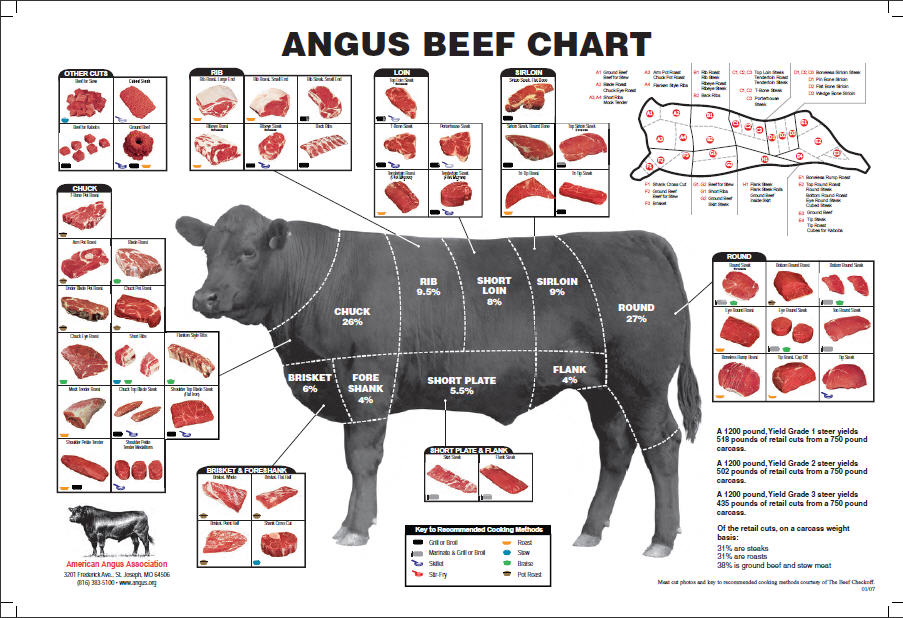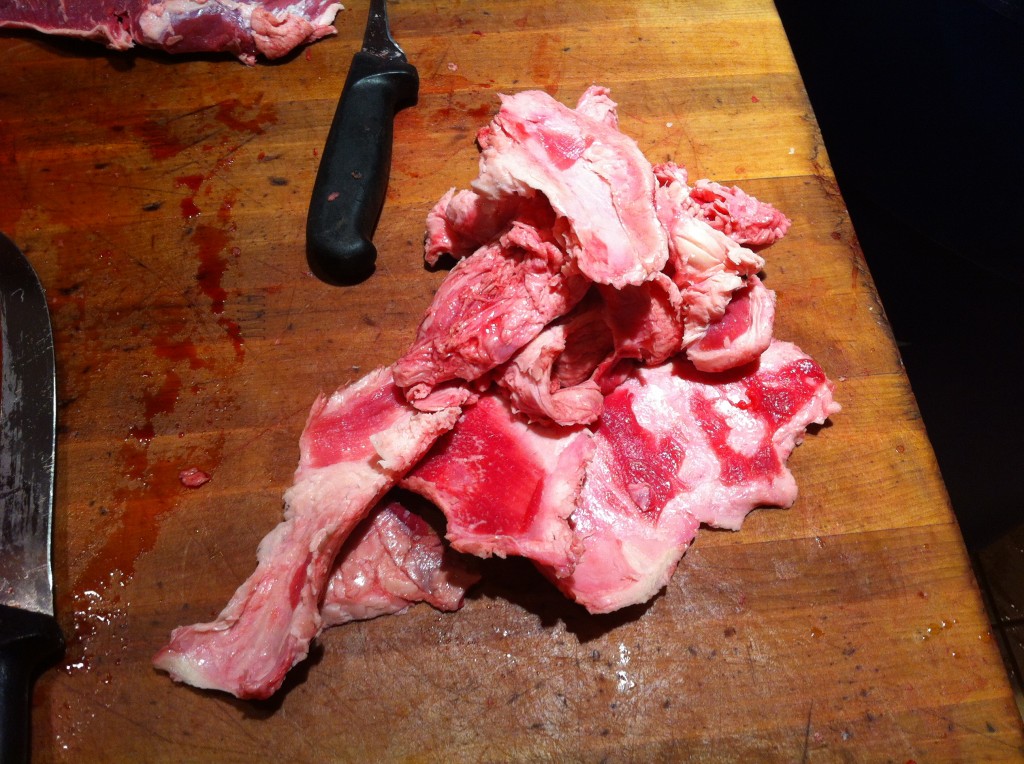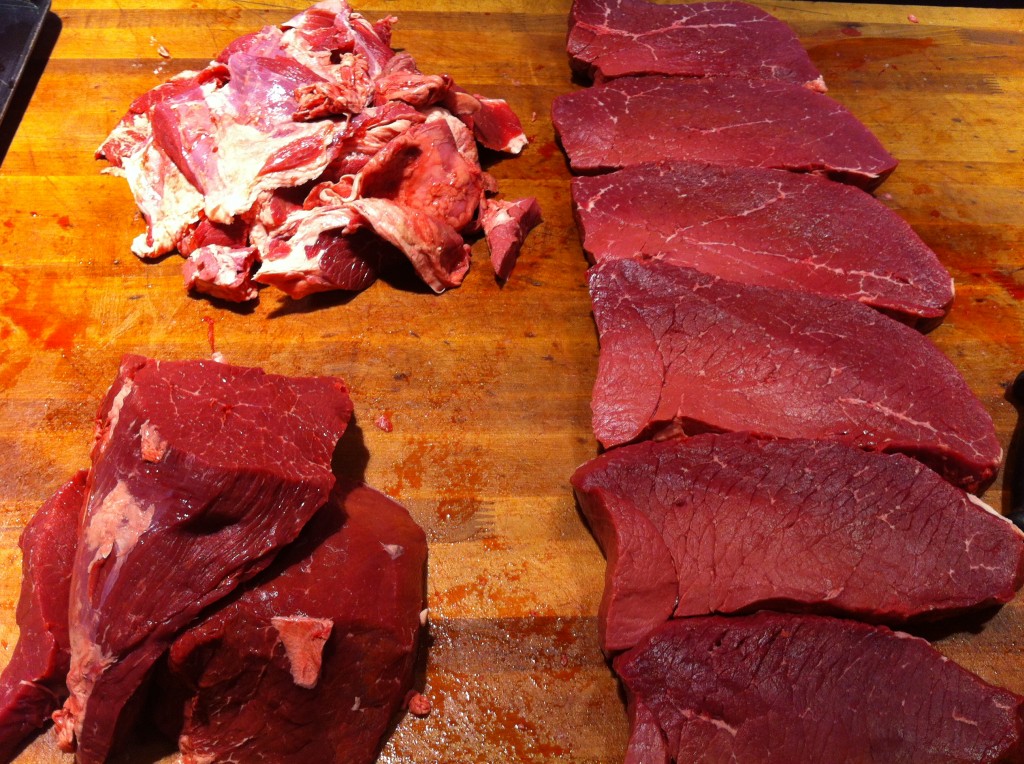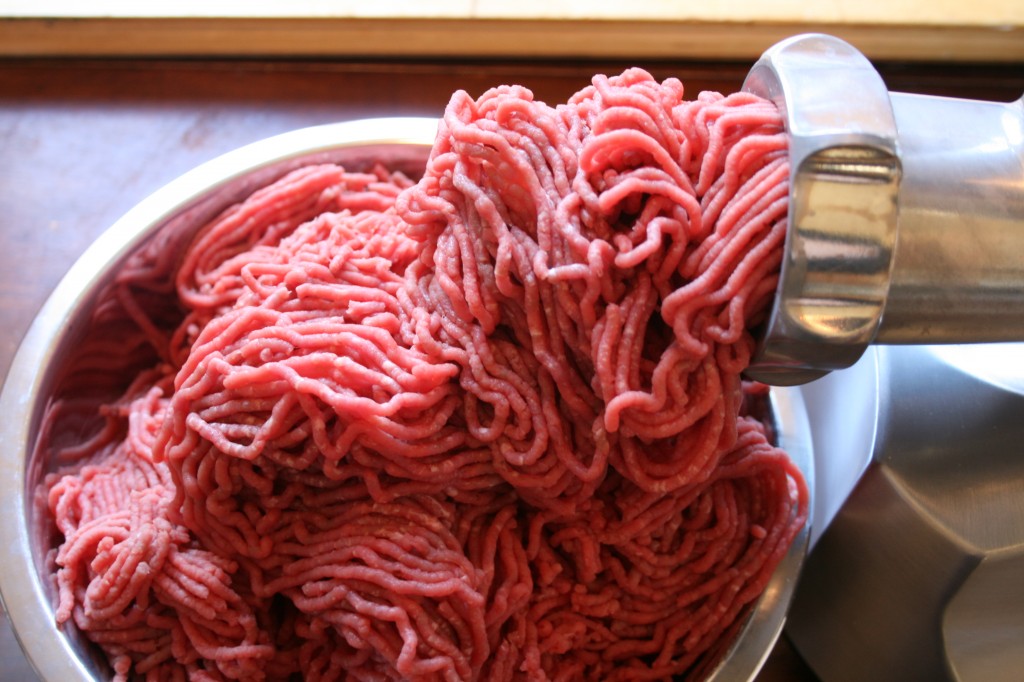
The Grind
Ground meat is meat that is finely chopped by, in most cases, a meat grinder, or a chopping knife. It goes the name of ‘minced meat’ in parts of the world outside the USA. I’m going ot focus mostly on ground beef, although all the examples I provide can be applied to the ground meat of any animal.
Most ground beef is sold by one of two ways: By percentage of fat content, ie; 90% lean, or 80/20 ground beef (80% muscle, 20% fat), or by the cut that meat was ground from, ie; ground chuck, ground round, or ground sirloin. Ground Beef sold by percentage of fat content usually contains meat from many sections of the cow, whereas ground chuck, for example, only conatins meat from the chuck (aka the shoulder). A maximum of 30% of fat by weight is allowed in ground beef sold in the United States.
Are we all familiar with a photo similar to this:  This shows a cow divided up into it’s main muscle groups, known as “Primals.” The Primals are then divided into “sub-primals” (further separation of the main muscle groups) and then the meat is cut into steaks, roasts, and miscellaneous cuts like stir-fry and stew meat. Before the subprimals are cut into steaks and chops that are visually appealing to the consumer, some trimming has to be done. Trimming consists of cleaning off any silver skin, excess fat, connective tissues, and oddly shaped pieces of meat that don’t look square and neat like we’re accustomed to seeing when purchased at the store. From these trimmings, we accumulate ‘trim.’ Some of this trim consists of large amounts of fat and connective tissues that don’t serve us much good; consumers don’t want ground beef that is excessively fatty, and some pieces of connective tissues are too gristly to pass through a grinder. These trimmings are usually discarded and sent off to a rendering company where it gets turned into animal feed, soap, biodiesel, etc. The rest of this trim is meat that either takes away from the visual appeal of well trimmed steak, or is too tough or gristly to benefit from most cooking methods. These trimmings are passed through a grinder, and turned into ground beef; perfect for hamburgers, tacos, meatballs, etc. Below are pictures of a top-round, which is a sub-primal from the Round. This is an example of how trim for ground beef is aquired:
This shows a cow divided up into it’s main muscle groups, known as “Primals.” The Primals are then divided into “sub-primals” (further separation of the main muscle groups) and then the meat is cut into steaks, roasts, and miscellaneous cuts like stir-fry and stew meat. Before the subprimals are cut into steaks and chops that are visually appealing to the consumer, some trimming has to be done. Trimming consists of cleaning off any silver skin, excess fat, connective tissues, and oddly shaped pieces of meat that don’t look square and neat like we’re accustomed to seeing when purchased at the store. From these trimmings, we accumulate ‘trim.’ Some of this trim consists of large amounts of fat and connective tissues that don’t serve us much good; consumers don’t want ground beef that is excessively fatty, and some pieces of connective tissues are too gristly to pass through a grinder. These trimmings are usually discarded and sent off to a rendering company where it gets turned into animal feed, soap, biodiesel, etc. The rest of this trim is meat that either takes away from the visual appeal of well trimmed steak, or is too tough or gristly to benefit from most cooking methods. These trimmings are passed through a grinder, and turned into ground beef; perfect for hamburgers, tacos, meatballs, etc. Below are pictures of a top-round, which is a sub-primal from the Round. This is an example of how trim for ground beef is aquired:
In a small butcher shop, this is how most trim for ground beef is acquired; from the trimmings of all the sub-primals that are cut for steaks. The method is the same for industrial beef processing plants, but on a significantly larger scale. Many large grocery-store chains get their beef trimmings sent to them from the beef processing plants, in addition to acquiring their own trim from within their own shop.
Now, as for the slime (you know, the pink stuff that’s recently reported to be in 70% of grocery store ground beef and in school lunches), I’m going to rant for a second: I’ve actually never seen the stuff firsthand, and I agree that it doesn’t sound or look very appetizing. While I am certaintly not advocating that pink slime is a healthy addition to your diet, I think the public hysteria surrounding the product is somewhat overblown. On one hand, I’m glad that the story broke because, if nothing else, it made many people aware that they really don’t have a clue what they are eating; Our industrialized food production methods in this country have succeeded in providing cheap food in large quantities, not ‘quality’ food. Consumer’s have demanded cheap food, and, using the example of pink slime, became outraged when they learned that cheap food is exactly what they’ve been given. If you’re only willing to spend ninety-nine cents for a hamburger, you’re going to get a ninety-nine cent hamburger.
Okay, I’m done ranting.
Where was I…oh yes, the slime. I’ll just give a brief overview of how the slime is made. Remember this picture? This is the excess fat I trimmed off the top-round. You should be able to notice that there is still a small amount of meat on the fat. Considering that I am not a machine, I am only human…sigh…, when trimming is done by hand, it is close to impossible to remove all the fat, gristle, and sinew without leaving some meat behind. This fat gets thrown into a rendering barrel (In industrial beef processing plants, they don’t use small trash cans for rendering barrels, and the trimming and de-boning of meat is done quite differently than in the pictures I’m showing you. While industrial meat processing is done differently than in a small butcher shop, the end product is essentially the same as what I’m showing you, albeit in much different quantities. I’m using these pictures as an example to illustrate what pink slime is made from).
This is the excess fat I trimmed off the top-round. You should be able to notice that there is still a small amount of meat on the fat. Considering that I am not a machine, I am only human…sigh…, when trimming is done by hand, it is close to impossible to remove all the fat, gristle, and sinew without leaving some meat behind. This fat gets thrown into a rendering barrel (In industrial beef processing plants, they don’t use small trash cans for rendering barrels, and the trimming and de-boning of meat is done quite differently than in the pictures I’m showing you. While industrial meat processing is done differently than in a small butcher shop, the end product is essentially the same as what I’m showing you, albeit in much different quantities. I’m using these pictures as an example to illustrate what pink slime is made from). See all the red in there? That red stuff is meat, and meat=money. By taking all these scraps and putting them into a centrifuge, the meat separates from the fat, and what you have left is a pasty-looking product that is about 90% lean beef. This is now passed through an ammonia gas or citric acid which is used to kill off any bacteria that isn’t safe to eat, such as e coli and salmonella (a quick note on the ammonia gas; it sounds really scary, but when the gaseous ammonia comes in contact with the moisture in meat, it turns into ammonium hydroxide. This is not the same thing as the ammonia you use to clean with. Ammonium hydroxide is actually used in a wide variety of food production methods including cheese, baked goods, and chocolate. In limited quantities the FDA claim that ammonium hydroxide is GRAS- generally recognized as safe.) The final product is then frozen and shipped off to grocery stores to be added as a cheap filler to ground beef.
See all the red in there? That red stuff is meat, and meat=money. By taking all these scraps and putting them into a centrifuge, the meat separates from the fat, and what you have left is a pasty-looking product that is about 90% lean beef. This is now passed through an ammonia gas or citric acid which is used to kill off any bacteria that isn’t safe to eat, such as e coli and salmonella (a quick note on the ammonia gas; it sounds really scary, but when the gaseous ammonia comes in contact with the moisture in meat, it turns into ammonium hydroxide. This is not the same thing as the ammonia you use to clean with. Ammonium hydroxide is actually used in a wide variety of food production methods including cheese, baked goods, and chocolate. In limited quantities the FDA claim that ammonium hydroxide is GRAS- generally recognized as safe.) The final product is then frozen and shipped off to grocery stores to be added as a cheap filler to ground beef.

I still am glad that the whistle was blown on the use of pink slime in food production. I think it’s just about as gross as velveeta “cheese” or twinkies (seriously, what’s in those those things?). I don’t eat pink slime, I don’t think you should eat pink slime, and I’m glad the public is becoming more aware of the fact that our industrialized food production methods are are more interested in profit than your health.
So, now that everytime you want burger but can’t bite into one without picturing that box of silly-puddy, what are you to do? Should you become a vegetarian? Blasphemy! The truth is, the chances of pink slime being in your ground beef these days is really slim; after the story broke, most of the fast food chains and grocery stores that admitted to using it have stopped, causing 3 of the 4 producers of the slime to go out of business. I could try and scare you into thinking that most of the ground beef you eat is contaminated with e-coli or or is somehow dangerous to consume, but the reality is that most of the ground beef you purchase is safe to eat. However, there still are usually a couple of ground beef re-calls a year (usually due to e-coli or salmonella contamination) and, unless you are buying beef from a small butcher shop that grinds their own beef, you are most likely buying ground beef that is made from the trim of hundreds of different cows. If your ground beef comes in a plastic tube, chances are it was made from animals raised in poor conditions, possibly from old dairy cows that are no longer fit for producing milk, and is probably not the highest quality. Because ground beef that is processed in such massive quantities has a higher risk of bacterial contamination, you are required to cook it well done (aka dry). The only way to truly know what’s in your ground beef, and to feel safe eating it, is to grind it yourself. By grinding your own beef, you can decide which cut (or cuts) of meat to use, customize the amount of fat in your grind, and have the peace of mind of knowing that you are eating truly fresh and pure ground beef. It’s ridiculously easy and quick too; you’re looking at about an hour, which includes setup and cleaning time. Let’s get started!
To grind your own meat you’ll need two things: a meat grinder, and meat. In my post about grinding meat for sausage, you’ll find a detailed description of the different meat grinders available for purchase, and what to keep in mind when deciding what type of meat grinder will best suit your needs. This post also goes over the general parts and asembly of a meat grinder. If you have a Kitchenaid mixer you can buy the meat grinding attachments separately.
When choosing which meat you’ll want to grind, you’ll need to decide how much meat you need; I like to grind large batches at one time, then portion it out and freeze what I don’t need right away. I’ll usually buy a 5 pound roast for this purpose, but it’s up to you; are you only grinding meat for a one time occasion, or do you want to grind meat to store in bulk?
The second thing to consider, is what cut of meat you want to grind. As long as you are working with a boneless piece of meat, any cut of meat can be ground. The main thing that you want to consider when choosing what to grind is: how much fat do you want in your grind? Ground meat with too little fat is usually dry and lacking in flavor, but is lean and is lower in fat and calories. Ground meat with at least 15% fat will hold up better for hamburgers, meatballs, or meatloaves, and will be more flavorful and juicy. In the meat world, fat=flavor. Below are the most popular cuts to choose from for grinding beef:
- Beef Chuck: 78%-85% lean (78%-85% muscle, 15%-22% fat)
- Beef Round (includes Top Round, Bottom Round (aka rump roast), Eye of the Round, and Sirloin Tip): 85%-93% lean; Will be closer to the 93% lean if all visible fat is removed before grinding.
Like I mentioned earlier, as long as it doesn’t have bones in it, you can put it through the grinder. There are fancy-schmancy recipes out there that call for you to grind things like short ribs, brisket, tenderloin, or ribeyes- and they swear that by grinding these really expensive cuts of meat that you’ll end up with a superior race of Hamburger, but, in my humble opinion, the only thing that determines the quality of your ground beef is the fat content. It doesn’t matter if the fat comes from the filet mignon, or the chuck; once you pass that meat through the grinder, the structural integrity of the meat is completely changed. The only thing you’ll want to look out for is large pieces of gristle or sinew. You’ll more likely find them on cuts from the chuck if the meat hasn’t been properly trimmed by your butcher. If you do find any gristle or sinew, discard those pieces.
OK, now that we have our meat grinder and our meat, guess what happens next? We grind the meat! I did mention earlier that making your own ground beef is ridiculously simple, right?
I have a 5 pound piece of Grass-Fed Top Round Roast that I chose to grind (I went with the lean option this time, trying to go down a notch on my belt…). You’ll need to cut up your meat into pieces small enough to fit through your grinder. If you are grinding meat that has more fat in it, the consistency of your hamburger will be better if you keep the fat very cold before grinding; some even say you should put your cubes of meat in the freezer for 30 minutes before you grind it. If the fat is too warm it will smear when it’s coming through the grinder, causing your hamburger to have a greater tendency to fall apart when cooked. It’s best to keep all your meat and equipment as cold as possible before grinding, and, if you are grinding in large quantities, keep the bowl you are grinding your meat into set on top of a bowl of ice to keep everything cold.
See, easy.
If you decided to grind meat in bulk, you can now portion out the meat and wrap it in saran wrap to store in the freezer until you are ready to use it.
A food scale is only necessary if you need to satisfy your OCD. To avoid freezer burn, make sure the meat is wrapped as tightly as possible. You can then place your individually wrapped portions in a zip-lock back to help further prevent freezer burn. You can keep ground beef in your freezer for about 4-6 months.
There you have it: the easiest way to be sure that you have the safest, freshest, purest, most awesom-est (insert adjectives ending with -est here) ground beef. So now you really can have your hamburger and eat too! Happy grinding!













2 thoughts on “The Grind”
Outstanding article… I agree with you on the pink slime. Thats why I rarely do fast food. All I need to grind is the attachment for the kitchenaide. Now if I could figure out how to smoke hamburgers…lol
Hi Sarah,
This is truly excellenct writing and great information. Plus interesting and helpful pictures and then a slightly disgusting picture of pink slime…it all works!
congrats!!
Comments are closed.